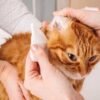Feline Treats: Should Cats Eat Ice Cream?
As adorable as it may seem to imagine a cat indulging in a cold and creamy treat like ice cream, it’s essential to consider their well-being and health before sharing this human delicacy with them. While cats are known for their curiosity and interest in our food, not all human treats are safe for feline consumption. In this article, we’ll explore whether cats can eat ice cream, potential risks, and alternative treats that are safer and more suitable for their diet.
1. Lactose Intolerance
Most adult cats are lactose intolerant, meaning they lack the enzyme lactase required to digest lactose, the sugar found in milk and dairy products like ice cream. Feeding a lactose-intolerant cat ice cream can lead to digestive issues, including diarrhea, stomach upset, and discomfort.
2. High Sugar Content
Ice cream is typically high in sugar, which is not a part of a cat’s natural diet. Feeding cats sugary treats can lead to weight gain, dental problems, and potential health issues like diabetes.
3. Fat Content
Ice cream is also high in fat, which can be challenging for cats to digest properly. A diet high in fat can lead to obesity and other health problems in cats.
4. Artificial Sweeteners and Flavors
Some ice creams contain artificial sweeteners like xylitol, which is toxic to cats and can lead to severe health consequences if ingested.
5. Cold Sensitivity
Cats are more sensitive to cold temperatures than humans, and giving them ice-cold treats like ice cream can be uncomfortable and even painful for them.
6. Safe Alternatives
Instead of ice cream, there are safer and more suitable treats for cats that they can enjoy. Commercial cat treats specifically formulated for feline consumption are available in pet stores. Additionally, some fresh fruits like small pieces of apple or watermelon can be offered as occasional treats in moderation.
7. Frozen Cat Treats
If you’re looking for a cool and refreshing treat for your cat, consider making frozen cat treats at home. Freeze small portions of plain, unsweetened yogurt or pureed fruits (without artificial sweeteners) in ice cube trays. These homemade frozen treats can be a more suitable and enjoyable option for your feline friend.
8. Veterinary Advice
Before introducing any new treats or food into your cat’s diet, it’s essential to consult with a veterinarian. They can provide personalized advice based on your cat’s individual health and dietary needs.
While the image of a cat licking ice cream may be endearing, it’s best to avoid feeding this sweet treat to feline companions. Cats lack the necessary enzymes to digest lactose and may suffer from digestive issues if they consume ice cream. The high sugar and fat content, along with the potential presence of harmful ingredients like xylitol, make ice cream an unsuitable treat for cats. Instead, consider safe alternatives and frozen treats made with cat-friendly ingredients to keep your feline friend happy and healthy. As responsible pet owners, ensuring that our cats have a balanced and appropriate diet is essential for their well-being and longevity.


